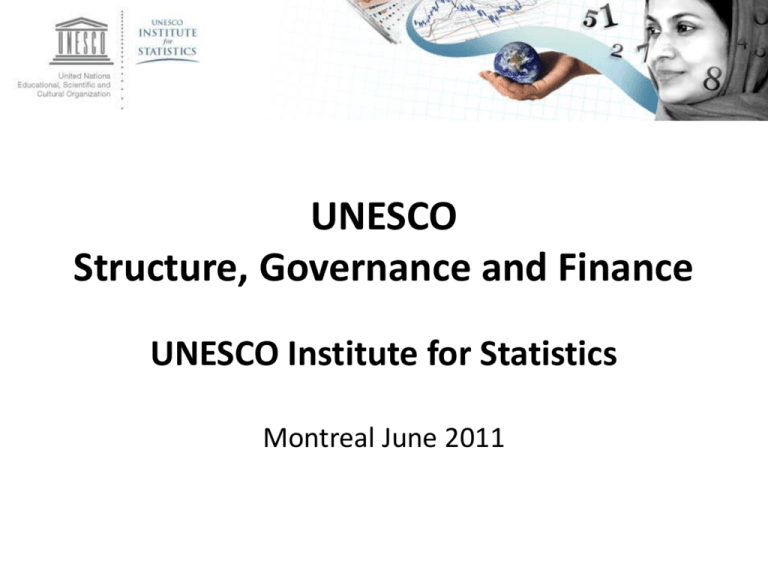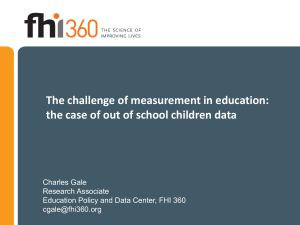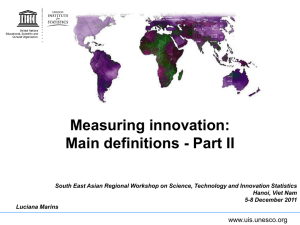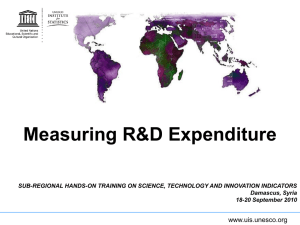Key performance indicators for Education
advertisement

UNESCO Structure, Governance and Finance UNESCO Institute for Statistics Montreal June 2011 About me Andrew Barton Data Processing and Standards Unit UNESCO Institute for Statistics a.barton@uis.unesco.org • • • • Bio: Statistical Assistant in the Data Processing & Standards Unit at the UIS Master’s in Economics from the University of Amsterdam Bachelor’s in Economics from JMSB Previous work as an adviser/analyst for a European finance and leasing industry, Department of Foreign Affairs and International Trade, and Catholic Community Services (NPO in Montreal) Presentation Outline • Overview: History, Mission & Priorities • UNESCO Structure & Governance General Conference Executive Board Secretariat • Financing • Differences between IGO and NPO Overview: History • 1942: Conference of Allied Ministers of Education - CAME – European countries looking to reconstruct their systems of education in the post war era • 1945: A proposal from CAME was made at a United Nations Conference for the establishment of an educational and cultural organization (London) • At the end of the conference, thirty-seven countries founded the United Nations Educational, Scientific and Cultural Organization (16 November) Overview: Mission & Priorities • UNESCO’s mission is to contribute to the building of peace, the eradication of poverty, sustainable development and intercultural dialogue through education, the sciences, culture, communication and information. • UNESCO focuses on two global priorities: – Africa & Gender Equality Overview: Mission & Priorities • The broad goals and objectives of the international community – as set out in the internationally agreed development goals (Millennium Development Goals and Education for All) – underpin all UNESCO’s strategies and activities. Overview: Mission & Priorities • In fulfilling its mission, UNESCO will carry out for the international community five established functions: i. ii. iii. iv. v. laboratory of ideas, including foresight standard-setter clearing house capacity-builder in Member States in UNESCO’s fields of competence catalyst for international cooperation UNESCO Governance and Structure • UNESCO is a specialized agency of the UN (carries out prescribed mandate but independent) • Based in Paris, France • Director General: Ms. Irina Bokova • UNESCO is an Intergovernmental Organization - IGO – Goals and scope are outlined in a treaty or charter – Membership is limited to nation states / countries • Three levels of membership (193 members, 7 associate members & 2 observers) – Members are required to make yearly contributions UNESCO Governance and Structure • Governing Bodies – General Conference – Executive Board • Secretariat – 2,000 employees of which 870 are located in 65 field offices around the world UNESCO Governance and Structure • General Conference – Primary decision making body of UNESCO – Meets once every 2 years to determine the policies and main lines of work of the organization – 1 country – 1 vote – Approves UNESCO’s biennial programmes and budget – Every 4 years, it appoints the Director General UNESCO Governance and Structure • Executive Board – Composed of 58 member states who are elected at the General Conference every two years – Choice of representatives depends on diversity of cultures and geographic regions – Responsible for the execution of the programme adopted at the General Conference – Meets twice a year to examine the Organization’s programme and budget UNESCO Governance and Structure • Secretariat – The Director General is the executive head of UNESCO – DG formulates proposals for appropriate action by the General Conference and Executive Board – DG prepares a draft biennial programme and budget – Staff implements the approved programme – Organizational Chart • Central Services • Programme Sectors • Support Sectors • Field Offices UNESCO Financing • Membership contributions – Represents 58% of the 2010-2011 budget – For 2010-2011: $653,000,000 USD • Extra budgetary funding – UNESCO becoming more reliant on extra budgetary funds – Represents 42% of the 2010-2011 budget – For 2010-2011: $462,751,400 USD • Total Budget: $1,115,751,400 USD UNESCO Financing • Five major sources of extra budgetary funding: – Bilateral Government Donors – The United Nations Funds and Programmes – Multilateral Development Banks (WBG) – The European Commission – The Private Sector UNESCO Financing • Biennial budget is submitted by the Director General as a resolution at the UNESCO General Conference for approval • Scale of Assessment – Set at the United Nations General Conference on a yearly basis • Assessment is based on a countries Gross National Income and a country’s capacity to pay • Contributions are to be paid partly in US dollars and partly in Euros (can pay in national currency) Members Contribution % USA 22.000% Japan 12.530% Germany 8.018% UK 6.604% France 6.123% Italy 4.999% Canada 3.207% China 3.189% Spain 3.177% Mexico 2.356% Others 27.797% IGO vs NPO • Similarities: – Both are not driven by profit – Funding sources are the same (public and private) • Differences: – NPO can represent both public and private interests – IGO represent public interests – Governance Structure (membership) • NPO structure depends on the type of organization • IGOs structure based on a charter or treaty between countries – Financing structure is different (i.e. UN scale assessment) List of IGO’s in Montreal • • • • UNESCO Institute for Statistics ICAO – International Civil Aviation Organization Secretariat on the Convention of Biodiversity Multilateral Fund for the Implementation of the Montreal Protocol • Commission for Environmental Cooperation (Canada, Mexico & US only) • Cospas Sarsat (Canada, France, Russia, & US only) UIS - Education Team An Overview of the role of the UIS in Education Statistics About me Peter Wallet TITLE UNESCO Institute for Statistics p.wallet@uis.unesco.org Bio: • Worked for over 8 years at the UIS • Contributed to the overall analysis and monitoring of international education targets Education for All Global Monitoring Report team • Particularly contributed to the development and analysis of data on teachers About me Lory Ajamian TITLE UNESCO Institute for Statistics l.ajamian@uis.unesco.org Bio: • • • • Statistical Assistant at the UIS within the Education team Worked on several UIS publications Currently doing her Master’s in Statistics at McGill Speaks 4 languages (French, English, Armenian and Chinese) The UNESCO Institute for Statistics • The UIS founded as a semi-autonomous institute in 1999 in Paris, France • Moved to Montreal in 2001 • Mandated to maintain international databases for: – Education – Science and technology – Culture and communications • Approximately 110 employees from which about 20% are based in various parts of the world. Regional Presence of the UIS Doha Dakar New Delhi Bamako Yaoundé Bangkok Nairobi Dar-es-Salaam Santiago Windhoek Apia Apia What is the role of UIS in education? • Collection of national data and subsequent conversion & dissemination of cross-nationally comparable data Different countries, different primary education systems Basic education 5 years 6 years 9 years Primary 4 years Lower secondary Development of international classifications, e.g. ISCED The 7 LEVELS of education are: – ISCED 0 = Pre-primary – ISCED 1 = Primary Destination A B C – ISCED 2 = Lower secondary – ISCED 3 = Upper secondary – ISCED 4 = Post-secondary non-tertiary – ISCED 5 = First stage of tertiary education (not leading directly to an advanced research qualification) – ISCED 6 = Second stage of tertiary education (leading to an advanced research qualification) Orientation General, Tech/Voc Kenya Senegal .. 26 .. 27 Doctorate 25 26 24 ….. Ens. uni (2eme cycle) 25 Master's 23 24 20 Bachelor's National poly/Dip Tech & Indus Teacher training 19 degree Voc Ed college 18 Training 16 Upper 15 secondary 13 Youth polytechnics Second stage of primary education 12 21 20 Grande ecoles d'ingenieurs Ens. universitaire (1er cycle) Ens. sec. technique (2eme cycle) Ens. tertiare non uni. Capacite en droit Formation professionnelle cycle long Form. prof. cycle court 16 15 Enseignment moyen (1er cycle) Ens. moyen prof. 14 13 11 12 10 9 22 19 Ens. sec. general 18 (2eme cycle) 17 17 14 Primary teacher training colleges Ens. uni (2eme cycle) 11 First stage of primary education 8 10 Enseignment elementaire 9 7 8 6 Pre-primary 6/7 Education prescolaire Kenya Senegal .. 26 .. 27 Doctorate 25 26 24 ….. Ens. uni (2eme cycle) 25 Master's 23 24 20 Bachelor's National poly/Dip Tech & Indus Teacher training 19 degree Voc Ed college 18 Training 16 Upper 15 secondary 13 Youth polytechnics Second stage of primary education 12 21 20 Grande ecoles d'ingenieurs Ens. universitaire (1er cycle) Ens. sec. technique (2eme cycle) Ens. tertiare non uni. Capacite en droit Formation professionnelle cycle long Form. prof. cycle court 16 15 Enseignment moyen (1er cycle) Ens. moyen prof. 14 13 11 12 10 9 22 19 Ens. sec. general 18 (2eme cycle) 17 17 14 Primary teacher training colleges Ens. uni (2eme cycle) 11 First stage of primary education 8 10 Enseignment elementaire 9 7 8 6 Pre-primary 6/7 Education prescolaire ISCED Kenya .. .. 6 24 27 Doctorate 26 ….. 25 24 23 26 Senegal .. Ens. uni (2eme cycle) 22 25 Master's 23 21 24 20 Bachelor's National poly/Dip Tech & Indus Teacher training 19 degree Voc Ed college 18 Training 16 Upper 15 secondary 13 5A 5B 4A 3A 3B 3C 17 14 Primary teacher training colleges Youth Youth polytechnics polytechnics 2A 2B 21 20 Grande ecoles d'ingenieurs Ens. universitaire (1er cycle) 19 Ens. sec. general 18 (2eme cycle) 17 Ens. sec. technique (2eme cycle) Ens. tertiare non uni. Capacite en droit Formation professionnelle cycle long Form. prof. cycle court 16 15 Enseignment moyen (1er cycle) Ens. moyen prof. 14 Second stage of primary education 12 13 11 12 10 9 22 Ens. uni (2eme cycle) cycle)/ First stage of primary education 1 8 11 10 Enseignment elementaire 9 7 8 6 Pre-primary 0 6/7 Education prescolaire What is the role of UIS in education? • Technical projects to improve data collection towards the production and usage of internationally comparable data • Technical capacity building within countries (at least every 2 years, regional workshops) • Analysis of comparative data • Advocacy for statistics in relation to UNESCO’s areas of interest What education topics does the UIS collect data on? The following topics are covered in the UIS questionnaire • Access • Participation • Progression-internal efficiency • Student international mobility • Teachers • Investment in education Core UIS data source: Administrative data • Administrative data come from official national ministries; national school censuses or EMIS system • UIS works cooperatively with governments to maintain country’s sense of ownership • Advantages of administrative data • Allow for regular and timely monitoring of education systems • Linked to education planning • Cost efficient • UIS estimates some missing data • UIS collects more than just participation data, which could be collected from household survey data, which allows for a more holistic view of national systems, e.g.. Finance data, teachers data etc… Major phases of the UIS education data production cycle Phase 1 Phase 2 Surve y design Data collection and processing Phase 3 Phase 4 Reporting data Data collection and processing • International statistics depend on… • Quality of raw data reported by countries • Quality of UIS data collection and • processing Quality of data reported by other international organisations, e.g. population and economic data. Specific mandates related to international agreements • The UIS has the mandate to monitor progress towards Education for All (EFA) and education-related Millennium Development Goals (MDG). • The gender parity index (GPI), which is the ratio of female to male values of a given indicator, is used to measure: – EFA Goal 5: Eliminating gender disparities in primary and secondary education by 2005, and achieving gender equality in education by 2015, with a focus on ensuring girls’ full and equal access to and achievement in basic education of good quality. – MDG Goal 3: Promote gender equality and empower women. Education for All (EFA) In March 1990, delegates from 155 countries, as well as representatives from some 150 organizations agreed at the World Conference on Education for All in Jomtien (Thailand), to universalize primary education and massively reduce illiteracy before the end of the decade. In April 2000, the World Education Forum in Dakar (Senegal) adopted the Dakar Framework for Action reaffirming the commitment to achieving the goals for Education for All by the year 2015. Education for All (EFA) 1. 2. 3. 4. 5. 6. Expand early childhood care and education Provide free and compulsory primary education for all Promote learning and life skills for young people and adults Increase adult literacy by 50 per cent Achieve gender parity by 2005, gender equality by 2015 Improve the quality of education Millennium Development Goals (MDG) The Millennium Development Goals are eight goals to be achieved by 2015 that respond to the world's main development challenges. The MDGs are drawn from the actions and targets contained in the Millennium Declaration that was adopted by 189 nations and signed by 147 heads of state and governments during the UN Millennium Summit in September 2000. Millennium Development Goals (MDG) Poverty and Hunger 1. Eradicate extreme poverty and hunger Education 2. Achieve universal primary education 3. Promote gender equality and empower women Health 4. Reduce child mortality 5. Improve maternal health 6. Combat HIV/AIDS, malaria and other diseases Development 7. Ensure environmental sustainability 8. Develop a global partnership for development Monitoring indicators: Goal 2: Target 2.A “Ensure that, by 2015, children everywhere, boys and girls alike, will be able to complete a full course of primary schooling”. Participation Net Enrolment Rate Progress Outputs Survival Rate to Last Grade Youth Literacy Rate Monitoring indicators: Goal 3: Target 3.A “Eliminating gender disparities by 2005 in primary and secondary education, and at all levels no later than 2015’’ Equal participation Gender Parity Index of Gross Enrolment Ratio Participation Net enrolment rate in primary education (NER) NER Enrolment in primary education of the official age group *100 The official primary school - age population Participation of children belonging to the official primary school age-population (SAP) Gross enrolment ratio in primary education (GER) GER Enrolment in primary education *100 The official primary school - age population The general level of participation in primary education. The capacity of the primary education system to enrol children of the primary school age-population. United Arab Emirates (2009) Entrance age: 6 year old Duration: 5 years Official age group: 6-10 SAP610 288,681 GER NER 302,375 *100 104.5% 288,681 258,890 *100 89.68% 288,681 Age population Enrolment in primary education 5 61,565 35,055 6 60,604 60,203 7 59,343 59,286 8 57,860 56,543 9 56,228 54,139 10 54,646 28,719 11 53,313 6,163 12 51,686 1,882 13 49,593 304 14 47,478 81 Total 302,375 Out of school children (OOS) Definition before 2005: Children of primary school age are counted as out of school when they are not enrolled in primary education. NER OOS 258,890 *100 89.68% 288,681 288,681 - 258,890 29,791 !!! Goal 3 • Promote gender equality and empower women – Target 3.A: Eliminating gender disparities by 2005 in primary and secondary education, and at all levels no later than 2015 • Indicators: Gender parity index of GER in primary, secondary and tertiary education Gender parity index of Gross enrolment ratio Purpose: The GPI measures progress towards gender parity in education participation available for women in relation to those available to men. It also reflects the level of women’s empowerment in society. Gross enrolment ratio for female GPI GER Gross enrolment ratio for male GPI: United Arab Emirates (2009) 145707 *100 GERFemale Female ? GER 139972 GER Female 104.1% 156668 ? *100 Male148709 GERMale GER GER Male 111.9% Age 5 6 7 8 9 10 11 12 13 14 Total Population Female Male 29,944 31,621 29,453 31,151 28,815 30,528 28,066 29,794 27,243 28,985 26,395 28,251 25,572 27,741 24,749 26,937 23,937 25,656 23,210 24,268 104.1% 0.93 GPIGPI GER GER ? 111.9% Enrolment in primary education Female Male 17,676 17,379 29,210 30,993 28,475 30,811 27,091 29,452 25,873 28,266 13,661 15,058 2,724 3,439 830 1,052 141 163 26 55 145,707 156,668 UIS Data Centre • The main product of the UIS is its database • The data centre is an online vehicle for accessing all data and indicators produced by the UIS • Over 1000 data and indicators on education for more than 200 member states • Complete time series data from 1970 to the most recent year • Updated three times a year (January, April and October) Major publications using UIS education data World Development Indicators (World Bank) Global Education Digest (UIS) EFA Global Monitoring Report (UNESCO) Millennium Development Goals Report (UN) Human Development Report (UNDP) The State of the World's Children Report (UNICEF) UNESCO Culture, S&T, Comm and Info UNESCO Institute for Statistics Montreal June 2011 About me Maya Prince Research Assistant, LAMP team UNESCO Institute for Statistics m.prince@uis.unesco.org Bio: • Research Assistant with the Literacy Assessment and Monitoring Programme (LAMP) team at the UIS • Bachelor’s in Economics with honors • Master’s in Economics – both from Concordia University Learning Outcomes Enrolment Repetition Completion Out of school What about children in school not learning? UIS & learning outcomes UIS Mandate: To collect data & produce statistics on all dimensions of education, with international comparability UIS will now add indicators of student achievement to its databases Observatory of Learning Outcomes Components • 1 GLOBAL DATABASE: develop and manage a database of student achievement indicators with full international comparability—an issue • 2 CATALOGUE: develop and manage a database of student achievement indicators that countries have, internal or external source; comparability—not an issue Other teams at UIS Provide UNESCO member states and the international community with timely, reliable, relevant and crossnationally comparable statistics • Culture • Science and technology • Communication and information UN Literacy Decade (2003-2012) • aimed at increasing literacy levels • UNESCO launched the Literacy Initiative for Empowerment (LIFE) in 2005 as a framework for achieving the Decade’s goals • LAMP Literacy Assessment and Monitoring Programme • Objectives: • • • • Methodological development Sustainable data production National capacities Guiding principles: Literacy assessment: necessity for sound policymaking • Literacy skill: levels (not binary) • Test questions reflect context • Countries that have participated in IALS/ALL or LAMP Timed Parking Textual and contextual knowledge Q. ‘Is this a camel or a donkey?’ Not a camel or a donkey. It is a wild camel. [answer marked as wrong] In Mongolian there are different terms for domestic (temee) and wild camel (khavtai). The respondent has not understood the conventions of textual authority. Interviewer training Maya? Observation in Mongolia Observation in Jordan Literate environments UIS impact on international policy “subtle advocacy”, not “direct advocacy” How? •our statistics •support to countries (training, providing guidelines and standards) •partnerships with IGOs/NGOs •our reports and publications UNESCO Communications Strategy UNESCO Institute for Statistics June 15, 2011 About me Shereen Joseph Communications Unit UNESCO Institute for Statistics shereenjoseph@gmail.com Bio: • Worked in Communications for over 10 years – 2 of those at the international level within the UIS • Bachelor’s in Microbiology from the University of Alberta • Master’s in Journalism at Concordia starting in September • Freelance Consultant Outline • • • • • • UIS Communications Strategy Shift in Strategy Who do we Serve? Reaching a Broader Audience GED 2010 UIS online database Guiding principles of communications strategy • Better explain the work, mandate and products of the UIS. • Expand dissemination of UIS data. • Reinforce transparency, impartiality and accountability. Shift in Comm strategy Comm in the past: Current situation: • Importance of physical events • Success measured in terms of media reports • Demand for instant access to information • Success to be measured in qualitatitive and quantitative terms. Who are our users? UIS data are used by policymakers, decision-makers, academics, students, consultants, educators, journalists, advocacy groups, government and intergovernmental agency officials and other statisticians. Three types of users: • Consumers • Cooks • Commentators Effective dissemination of UIS data Highlights the need to diversify the format of outputs via: • Redesign of website • Redesign of UIS Data Centre • Use of Social Media Challenges in the digital age • Information overload • Discovery is difficult • Preferences for multi-channel dissemination • Identifying and reaching new audiences • Time and the expectation of instantaneous results Overcoming obstacles • Search Engine Optimization • Establishing cross-linkages with UNESCO site • UIS Document Library • Social Media • New Partnerships with Private Vendors GED purpose • The UIS data collection mechanism is designed to produce comparable data for over 200 countries and territories • The GED is part of a major UIS initiative to improve the availability of education data to monitor long-term progress globally and identify advances and setbacks of individual countries Education Disparities in 2010 Report Global Monitoring Education for All Gender GED 2010 - Gender Disparities in Education Between promise and progress GED 2010 • 2010 marks the 15th anniversary of Beijing +15 (the 4th World Conference on Women) • Reflects two of UNESCO’s top priorities: education and gender equality Online database • This GED is complemented by an interactive database accessible online at www.uis.unesco.org • The database contains additional indicators and time series data that are not presented in the print version of the Digest • The database is updated regularly and provides access to the latest international education data available MERCI THANK YOU 謝謝 GRACIAS ًشكرا Спасибо 78 Questions? • Peter Wallet – p.wallet@uis.unesco.org • Lory Ajamian – l.ajamian@uis.unesco.org • Andrew Barton – a.barton@uis.unesco.org • Maya Prince – m.prince@uis.unesco.org • Shereen Joseph – shereenjoseph@gmail.com






